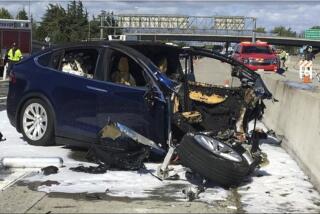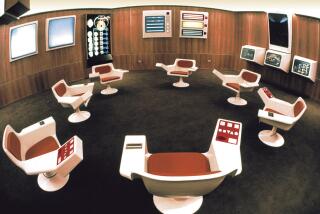The Cutting Edge: Computing / Technology / Innovation : Robot Teams: One Brain for All
Rather than equip each robot with all the intelligence it needs to do a complex job, researchers at the University of Tokyo’s Department of Mechano-Informatics are developing collections of robots that share “brain” hardware via wireless modems. The shared brain consists of a parallel processing computer capable of running the control software of many different robots. This allows the robots to be agile, since they don’t have to lug around a massive parallel computer.
The project features a collection of small, mobile units, each with a single specialty. One might carry a video camera, another a flashlight, another a gripper. All the robots can assemble at a given time and place and interact to form a more complex robot. A vision robot and two gripper-equipped robots could cooperate to tie a knot in a string. Each of the robots would be communicating with others through the shared brain. After the task was completed, they would be used in different configurations to perform different tasks.
Oil Is Faster Than Water: The petroleum-rich Los Angeles Basin may have more oil than previously supposed, according to a computer simulation developed by researchers of the University of Illinois and U.S. Geological Survey. Oil companies have always assumed that migrating oil settles in “traps” within about 10 miles of a known source bed. They assumed that subterranean oil and water moved at comparable speeds.
By using a computerized simulation, University of Illinois geologist Craig Bethke found evidence that oil migration is more rapid and occurs more efficiently than scientists had believed. Indeed, Bethke says that in some instances, oil travels through the sandstone underlying the Los Angeles Basin 100 times faster than water--and less oil is lost to ground absorption if it moves rapidly. Bethke’s research has been supported by funds from a consortium of 10 oil companies, three national laboratories, two computer companies and the Geological Survey. One result of the simulation work is that oil traps identified but not yet explored--because geologists thought they were too distant from the source--will now be investigated.
Model Factories: The U.S. flat-panel display industry doesn’t have much in the way of factories, but thanks to Sandia National Laboratories, it will soon have a good software model of what operating such a factory might cost. Flat-panel displays have been identified by the Clinton Administration as critical to the nation’s economic competitiveness and military preparedness. The technology is used for display screens on portable and notebook computers. Military applications include cockpit instrumentation, command and control centers and battlefield-portable computer and communications systems.
A few Japanese companies are producing about 90% of the world’s flat-panel displays. With no experience in volume manufacturing, U.S. companies will continue to be at a severe disadvantage.
Enter the National Center for Advanced Information Components Manufacturing, staffed by representatives of the Sandia, Los Alamos and Lawrence Livermore national laboratories. The center is working on projects with industrial partners and developing software tools to help the U.S. flat-panel display industry develop cost-efficient equipment and factories.
The center recently produced a Cost of Ownership software model for operating a piece of equipment and is now developing a Factory Cost model to determine what it would cost to run a flat-panel display factory. The idea is to produce financial models so that businesses can present bankers and other potential backers with a realistic picture of how much money is needed to get started.
Cold Probe, Warm Heart: Tissue damage that can cause arrhythmia (irregular heartbeat) is currently treated with medication or electrical burning, but both methods have drawbacks. The medication is not always effective and can have side effects; electrical burning cannot safely treat enough tissue to cure all types of arrhythmia. A third way to treat the problem is to freeze the heart tissue.
Aegis Medical Technologies of San Diego recently signed a cooperative research and development agreement with the National Institute of Standards to develop a catheter that could be inserted into a vein for freezing the damaged area. Attempts to develop such a catheter have been hindered by inability to reach sufficiently low temperatures.
The NIST will work with Aegis to develop heat-exchange and fluid technology to design a catheter that can reach temperatures between minus 150 and minus 190 degrees Celsius.






